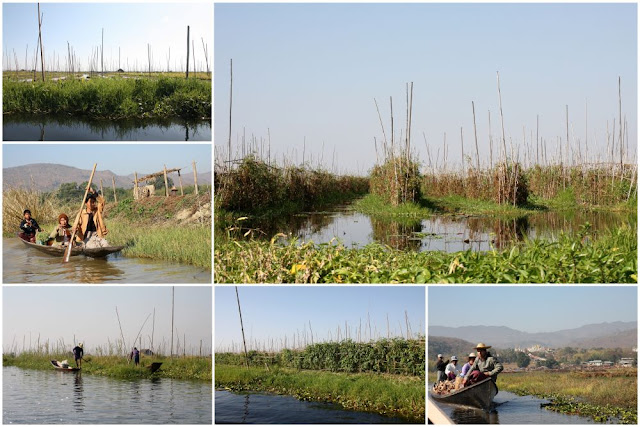Z Manili udaliśmy się do Baguio,
położonego w górach miasta, największego na Filipinach ośrodka
uniwersyteckiego. Liczyliśmy, że zajedziemy do przyjemnego,
spokojnego, górskiego miasteczka a zamiast tego znaleźliśmy się w
metropolii. Stąd nasz pobyt w Baguio ograniczył się do
popołudniowej wizyty na targu, bardzo zresztą ciekawym, gdzie
zakupiliśmy nasze pierwsze lokalne mango i truskawki oraz do jednego
noclegu. Już kolejnego dnia z rana wsiedliśmy w autobus do Sagady.
W Baguio już popsuła się pogoda, jakiś tajfun uderzył w
południowe Filipiny i cały obszar kraju znalazł się w chmurach i
deszczu. Ogromna szkoda, bo bardzo niewiele widzieliśmy z bardzo
malowniczej, górskiej drogi do Sagady, wszystko zasnute było
niskimi chmurami i mgłą. W pewnym momencie temperatura mocno
spadła, gdy w końcu wydrapaliśmy się na przełęcz na wysokość
ok. 2500 m npm. Sagada położona jest jakieś 1000 metrów niżej i
ma łagodniejszy klimat. Dookoła góry porośnięte są lasami
sosnowymi, a w małych wioskach mieszkają plemiona, które do dnia
dzisiejszego kultywują niektóre swoje tradycje. Sagada słynie z
wiszących na skałach trumien oraz z jaskiń. Na szczęście
kolejnego dnia przestało nieco padać i mogliśmy się wybrać na
spacer w okolice doliny Echo by zobaczyć te niezwykłe formy
pochówku. Zadziwiające jest z jakim mozołem przywiązywano trumny
wysoko do pionowych skał. Widok robi niesamowite wrażenie. Jest też jaskinia
u wlotu której ustawiano trumny i oczywiście dojście do tej
jaskini też wcale nie jest łatwe. W Sagadzie znajduje się malutkie
muzeum, prowadzone przez starszą panią, która od 40 lat zbiera
przedmioty użytku codziennego wyprodukowane przez tutejszą ludność
i bardzo ciekawie opowiada o dawnych zwyczajach. Z Sagady, pokonując
kolejną przełęcz (w potokach deszczu) przenieśliśmy się do
Banaue. Banaue słynie z bardzo malowniczych tarasów, na których
uprawia się ryż. Unikalne jet to, że tarasy te zbudowane zostały
z wielkim wysiłkiem i precyzją na bardzo stromych zboczach gór
wiele wieków temu. Zostały one wpisane na listę UNESCO i
rzeczywiście wyglądają niesamowicie. Samo Banaue to nieduże
miasteczko, wielkości Sagady, w centrum jest targ (z pysznymi,
tanimi owocami mango!), sporo sklepów, kilka hotelików, szkoła,
misja katolicka z kościołem i wszędzie dookoła, jak okiem sięgnąć
ciągną się stopnie tarasów, niczym ogromne zielone schody :-)
Pogoda niestety nadal bez zmian, ciągle pada, więc ograniczyliśmy
się do krótkich spacerów po okolicy. Nasz mały hotel ma na
szczęście piękną, dużą werandę z cudnym, panoramicznym
widokiem na okolicę, więc siedzimy sobie pod dachem i sącząc
piwko czytamy książki. Na targu za rogiem kupujemy słodkie jak miód mango (po ok 1 $ za kg) i zajadamy się tymi pysznymi owocami na zapas bo w Krakowie nie ma co o nich marzyć. Dziś wieczorem ruszmy na południe w
kierunku mniejszych wysepek :-)
We left Manila to travel to the hill
country in the north. Our first stop was Baguio which we expected to
be a small hill station somewhat like the old British colonial ones
dotted all around Asia. Instead we found a heaving, noisy, smelly
metropolis of approx. 2 million people. Well over half are students
as Baguio is the biggest university and high school center in the
Philippines. The weather had already started to deteriorate due to a
a tropical low which had enveloped most of the country. We managed to
have a look round the main market which was really interesting and
some of the handicrafts are quite beautiful, specially the basket
weaving and wood carvings. We also sampled our first local
strawberries and mangoes. The following morning, early, we cought a
bus to travel to Sagada further north in the mountains. By this time
the weather had really deteriorated with almost constant rain, low
cloud and mist. Unfortunately we were unable to see the spectacular
views along the route as we climed ever higher into the mountains. We
reached the highest point of 2500m which was still covered in mist
and cloud. We arrived in Sagada which is famous for its ancient
burial sights of hanging coffins. These date back to the times of
shamanism and are most interesting. It is amazing how they were fixed
quite high up onto the almost vertical sides of the cliffs. We also
managed to get down and see the coffins in a burial cave. The people
are still predominantly the decendants of the various hill tribes who
in past times were head hunters. An elder lady from the local tribe
started over 40 years ago what is a small unique museum. She's been
collecting since that time artefacts and household items and she
gives a very interesting lecture about the use and traditions of
these objects. We continued on our journey to another hill town
called Banaue. This is famous for its UNESCO listed rice terraces
which cover most of the steep slopes in and around Banaue and the
numerous villages. Some of these date back hundreds of years and they
still produce vast amounts of rice from them. Unfortunately the
weather has not cleared at all and we were unable to reach the
various view points in the area as they were all covered in the mist
and cloud. Fortunately the lodge we are staying in has a beautiful
terrace overlooking the valley so we have been able to relax with a
book and a beer. This evening we go by overnight bus back to Manila
and then further south by bus and boat to the smaller islands. It
must be said that the people here are also very friendly but the food
is still nothing to write home about although we are enjoying
stuffing ourselves with local mangoes! Hopefully as we move south we
will be able to enjoy fresh seafood and other Philippino delights.
Sobotni targ w Sagadzie / Saturday market in Sagada
Dolina Echo i wiszące trumny / Echo Valley and hanging coffins
Tarasy ryżowe w Banaue / Rice terraces in Banaue





















































